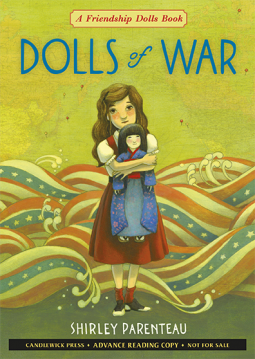 DOLLS OF WAR, by Shirley Parenteau, Candlewick, Nov. 14, 2017, Hardcover, $16.99 (ages 8-12)
DOLLS OF WAR, by Shirley Parenteau, Candlewick, Nov. 14, 2017, Hardcover, $16.99 (ages 8-12)
In the mid-1920s, Japanese and American children exchanged dolls as a way to ease cultural tensions between the two countries. These friendship dolls became prized possessions until WWII. Shirley Parenteau’s Dolls of War tells the fictionalized story of one such doll.
Macy James lives near the Oregon coast with her parents and brother. Macy loves to spend time at the small museum where her father is the director. Her favorite exhibit though is Miss Tokyo, one of fifty-eight exquisite friendship dolls given to America by Japan in 1926. Macy and her mother love Miss Tokyo and visit her daily. They talk to her and have tea parties.
When Macy’s mother passes away from a lingering illness, it’s Miss Tokyo that pulls Macy through. The doll is a part of both of them. She somehow keeps them connected. But when the Japanese bomb Pearl Harbor, many of Macy’s neighbors demand that Miss Tokyo be destroyed.
Macy can’t understand how a doll has anything to do with these evil acts and vows to protect Miss Tokyo. When her brother and his best friend join the Navy, Macy follows through with her promise. But when bad news starts to pour in, Macy begins to question her own loyalty. Can she remain true to both Miss Tokyo and America?
Prior to reading Dolls of War, I had never heard of the friendship dolls. I have to say that I found the whole thing fascinating and started doing some research of my own. It turns out Japan sent 58 friendship dolls to the United States in 1927. Of those 58, 45 remain. The majority of the dolls are in museums. Of the more than 12,000 dolls America sent to Japan in 1926, less than 350 survived WWII. Most of those are now in museums as well.
Dolls of War is a bit insular in its telling, focusing mainly on Macy and Miss Tokyo and the area in which Macy lives. The book touches a bit on Japanese internment camps, and people taking things that belonged to their Japanese neighbors, but doesn’t delve too deeply.
Instead, there’s an undercurrent of fear and hate — something that must have been terrifying for young children. Author Shirley Parenteau does a fantastic job showing this through Macy’s eyes. The thought of children running around the schoolyard and shooting down pretend Japanese airplanes is chilling.
Parenteau also delves into daily life during war. She really makes you understand what it was like living with the rationing and blackout requirements of the time.
Shirley Parenteau has written two more books about the dolls — Ship of Dolls and Dolls of Hope — set in 1920s America and Japan respectively. They are both now on my to-read list, as is Kirby Larson’s The Friendship Doll, which is set in the same time period. I’m hoping that Parenteau has a sequel to Dolls of War set in Japan in the works. I’m sure it would be an equally captivating read.
